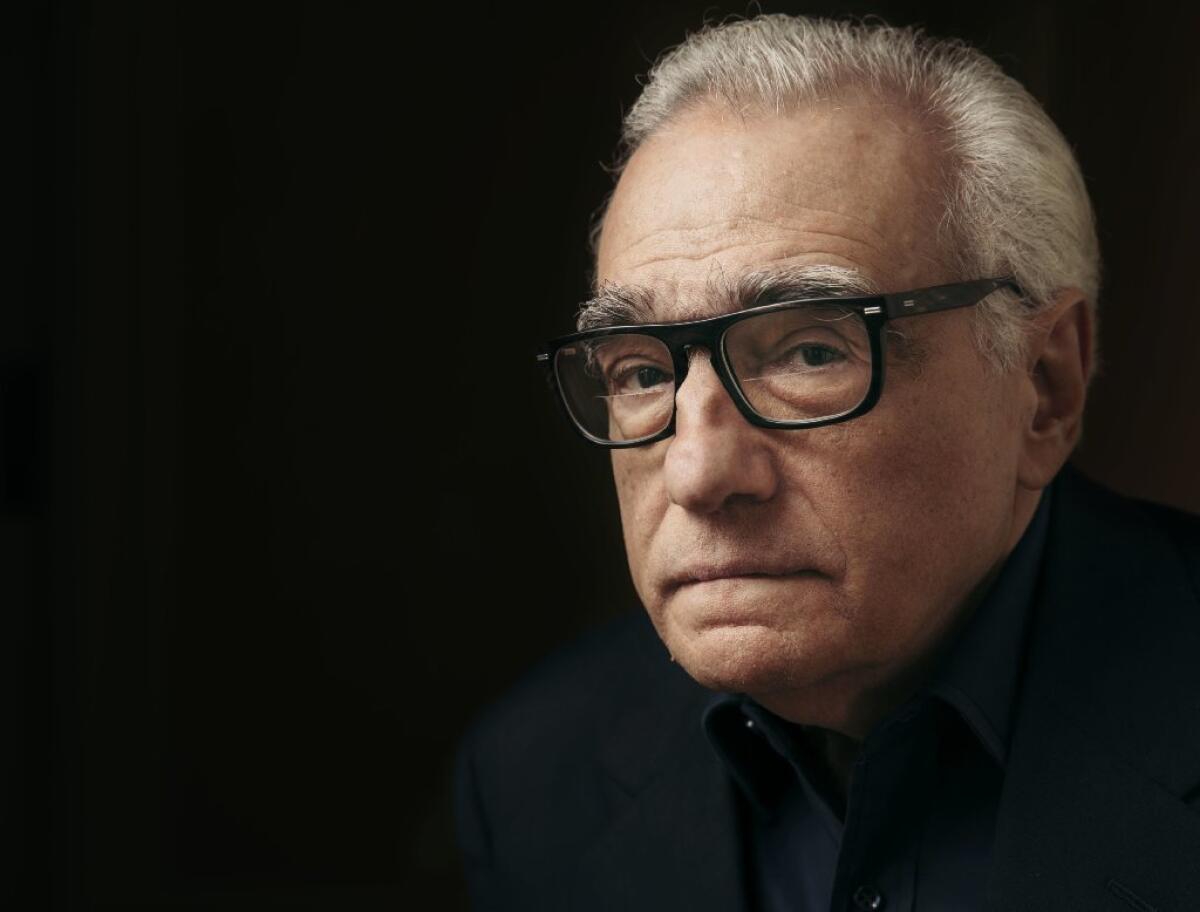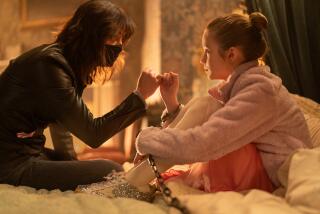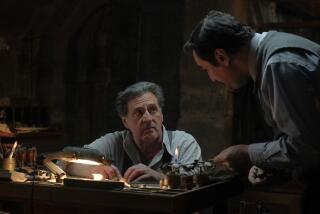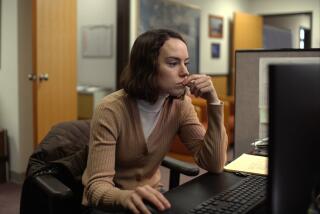‘Silence’ is the movie Martin Scorsese has waited a lifetime to make

Signs around the Hotel Bel-Air, where Martin Scorsese likes to stay when he’s in Los Angeles, make their decorous hopes known. The painted-on directives throughout the canyon retreat strongly encourage quiet — an apt message for a man who just made a movie called “Silence.”
Yet coming upon the auteur in a shaded courtyard suite on a recent afternoon, a reporter finds him with plenty to say.
“I like it here, it’s very peaceful. You want the bustle when you’re younger. Of course, when you have kids, then there’s always bustle. And if you have a child when you’re older, like I did, you’re always around it,” Scorsese said in his machine-gun stream-of-consciousness voice you would recognize even if it was speaking Mandarin. “But sometimes you just want a little peace and quiet. Sometimes silence is good, even if you’re busy. I guess that’s a little bit of a contradiction.”
The director has embodied numerous paradoxes throughout his career. He’s a child of American cinema’s ’70s rebel movement (“Oh, yes, Brian and George and Steven,” he says, referring informally to his time with contemporaries De Palma, Lucas and Spielberg. during that decade) who has nonetheless spent much of the 21st century making movies for studios. He’s a purebred New York auteur whose violence-spackled movies go over well in Middle America.
With his new movie, starring Andrew Garfield, the filmmaker offers up perhaps his greatest self-contradiction: “Silence” distills the concerns Scorsese has been investigating for decades — sacrifice, loyalty, guilt, identity — yet channels them not into a blood epic but far rarer waters of serenity and spirituality (and, granted, some violence).

Andrew Garfield, Adam Driver, Tadanobu Asano, Ciarán Hinds and Liam Neeson star in Martin Scorsese’s “Silence.”
“I remember sitting on set one day after I had shot all my takes, just off to the side having a snack,” recalled Garfield. “And I looked over at Marty working, and he was in a courtyard, sitting there in what looked like a prayer position. And on the monitor in front of him is an image of Christ. And I thought, ‘That’s his life. His whole life. Cinema and Christ. It’s everything.’ ”
Based on Shusaku Endo’s historical novel about 17th century Jesuit missionaries in Japan, “Silence” tells of two Portuguese men of the cloth, Sebastião Rodrigues (Garfield) and Francisco Garrpe (Adam Driver).
Learning that a mentor (Liam Neeson) has turned apostate to avoid martyrdom, they set off from Macau to track him down. When the pair arrive, they find the minority Christian population persecuted for their beliefs, particularly at the hands of the so-called Inquisitor Inoue Masashige (Issey Ogata). The high-stakes question — for them and consequently for Christianity’s future in Asia — is whether to renounce Jesus or die a martyr. Where previous spiritual forays “Kundun” and “The Last Temptation of Christ” looked at religion in a given place, this examines the collision between the two, an east-meets-west battle over how the world should worship.
At an energetic 74 and five decades into a career that shows no sign of abating, Scorsese has made a movie about an epic quest.
It took a similar effort to bring the film to fruition.
Scorsese’s long “Silence” journey, by now familiar to many Hollywood insiders, began in 1989, when he read the novel and found himself moved: It evoked his own Roman Catholic childhood in New York’s Little Italy and (mostly favorable) experience as an altar boy.
He optioned it, then began developing a movie. Financing seemed imminent at various points. “I think I prepared the movie five times,” said production designer Dante Ferretti, who has made nine films with Scorsese. “I was in Japan, North Carolina, California, New Zealand. And then, at the last moment, it was [always], ‘Sorry, we have to postpone.’ ”
Financiers would drop out, or a lawsuit would come in. (The film faced many legal hurdles, both due to the book’s long chain of title and because several Italian producers had a longstanding suit against Scorsese for not making the movie in the 1990s.) Scorsese would at times also be unhappy with the script, co-written with Jay Cocks. He thought he’d finally arrived in 2009, telling his team that he would make “Silence” right after he finished “Shutter Island.” Instead, he ended up making “Hugo,” then “The Wolf of Wall Street.”
After “Wolf,” though, Scorsese meant it.
Marty is very exacting in every aspect of his life, and particularly his filmmaking. And here he was willing to make some hard decisions, to compromise.
— Emma Tillinger Koskoff, “Silence” producer
“He said, ‘Forget the budget I want — tell me what it takes to get the movie made and I’ll do it,’ ” said producer Emma Tillinger Koskoff, who has worked with Scorsese on half a dozen films. “And that was something I had never heard before. Marty is very exacting in every aspect of his life, and particularly his filmmaking. And here he was willing to make some hard decisions, to compromise.”
The auteur agreed to make the epic for $23 million after incentives and $46 million before them, some tens of millions less expensive than earlier incarnations. At the suggestion of Ang Lee, he agreed to shoot in Taiwan, a less expensive locale than Japan. He went to the market at the Cannes Film Festival and did a dog-and-pony show for foreign distributors to raise about half the budget, then didn’t panic as another investor fell out weeks before shooting, leaving the project about $10 million short. (OK, so he also wasn’t told about that one until the cash was found elsewhere.)
That headstrong ferocity, which Scorsese retained even as his high-powered manager and agent kept trying to steer him toward more commercial fare (“It got to the point where my reps didn’t want me to go near it”), might seem mysterious. Why was it so important for the king of gritty urban Americana like “Taxi Driver” and “Goodfellas” to spend nearly 2½ hours with religion-debating Jesuits in period Asia?
Scorsese can’t explain it except to say that he felt impelled by a personal force.
“What I’ve been trying to get at for a long time is the idea of forgiving yourself,” he said. “I was able to do it at the end of ‘Raging Bull,’ when Jake [LaMotta] recited the soliloquy from ‘On the Waterfront.’ I was able to do it on film. But I wasn’t able to do it in life. And I needed this movie to do it in my life.”
He is vague, as he is about much in his personal affairs, about what he needs to forgive himself for, whether it pertains to his relationships (he has been married five times) or other matters.
But he does suggest that his profession is involved. “It had to do with my belief about my vocation as a real way to live,” said the director. “It’s really tricky if you’re a director — there’s a lot of ego and a lot of bombast and a lot of selfishness. And there’s something beyond that in life. Or at least I’m looking for something beyond that.”
He says he has concealed religious preoccupations in his films for too long, camouflaging them in the codes of Mafia men and police officers. “No more hiding,” he said. “Not with this movie.”
That helps explain why the film has such an overtly religious feel to it. “Silence” is a movie (title notwithstanding) about talking, even if words are used as a weapon, and even if actual weapons are sometimes used too. But maybe more central than any other idea is the importance of symbols and spaces in representing belief. In the movie, Christians struggle with whether to commit apostasy by stepping on a medallion image of Christ called the fumie. And, indeed, the film’s big question — of whether Japan will turn Christian — suggests the director’s embrace of geographic conceptions of the holy and profane.
“As I was ready to shoot a scene, Marty walked in front of me,” said Ogata, who plays the Inquisitor with an unexpected comic touch. “And then he quickly said, ‘Sorry, this space is yours,’ and went behind me. He felt like he shouldn’t go in front of me because it was a sacred space where the scene would take place. It was magical. It felt like Marty’s spiritual view of the world.”
Not that “Silence” didn’t face some very human challenges.
“The scene where Andrew is captured by the samurai, it was 90 degrees, not a cloud in the sky, 90 percent humidity, I look over and Marty is directing in his socks. It was hilarious,” sad Tillinger Koskoff. “And then the next day when a character is supposed to be getting tortured on the beach and it’s a monsoon. And it’s 4 a.m. of the day we were going to shoot and one of the assistant directors called me to say it’s thundering and lightning and the hair-and-makeup tents are blowing off the mountainside and everyone is huddled by the bus. And I said to Marty ‘we can’t shoot’ and Marty said ‘no no, put out the rain gear and shoot.”
Part of that indomitability may come from a personal sense of faith. And part of it may derive from him keeping an eye on different kind of divine presences.
“Off on the side in our edit room, not in our eyeline but in a way you feel is there, Marty often has Turner Classic Movies on,” said editor Thelma Schoonmaker, for whom “Silence” is her 18th movie with Scorsese. “There’s no sound, but sometimes when we’re working, he’ll just say, ‘Wait, look over at this actor or this director; he’s going to do a great thing in just a second.’ It’s inspiring.”
Schoonmaker also brings up the spiritual aspect -- how, in a time of religious persecution, “Silence” will resonate anew. Indeed, while Scorsese’s “Silence” journey began more than 25 years ago, the film is reaching the public at an urgent moment — when Islamic State and secular armies battle in the Middle East and tensions mount between liberal values and religious freedom laws in this country.
Scorsese offers no easy answers. He does not impugn religion but, unlike a Mel Gibson, he also doesn’t venerate martyrdom for its own sake. Viewers will make up their own minds whether those who choose to become apostates are doing the right thing.
Ultimately, he said, he can speak confidently only about his own life and the movie’s cleansing power on him. And even though he will return to familiar ground — “The Irishman,” a mob story with Robert De Niro — for his next film, he feels a certain reset has taken place.
“You know, I interviewed Jerry Lewis onstage once. And Jerry’s a tough man. But he said, ‘If I’m not enjoying myself, I’m doing something wrong,’ ” Scorsese recalled.
“Through the process of the work, the composition, there’s a searching. If you believe you’ve been given a gift and use it to tell stories, it can be purifying. Now that I made ‘Silence,’ the next movies will be like starting from zero. And I’m going to make them with forgiveness and enjoyment.”
See the most-read stories in Entertainment this hour »
On Twitter: @ZeitchikLAT
More to Read
Only good movies
Get the Indie Focus newsletter, Mark Olsen's weekly guide to the world of cinema.
You may occasionally receive promotional content from the Los Angeles Times.







